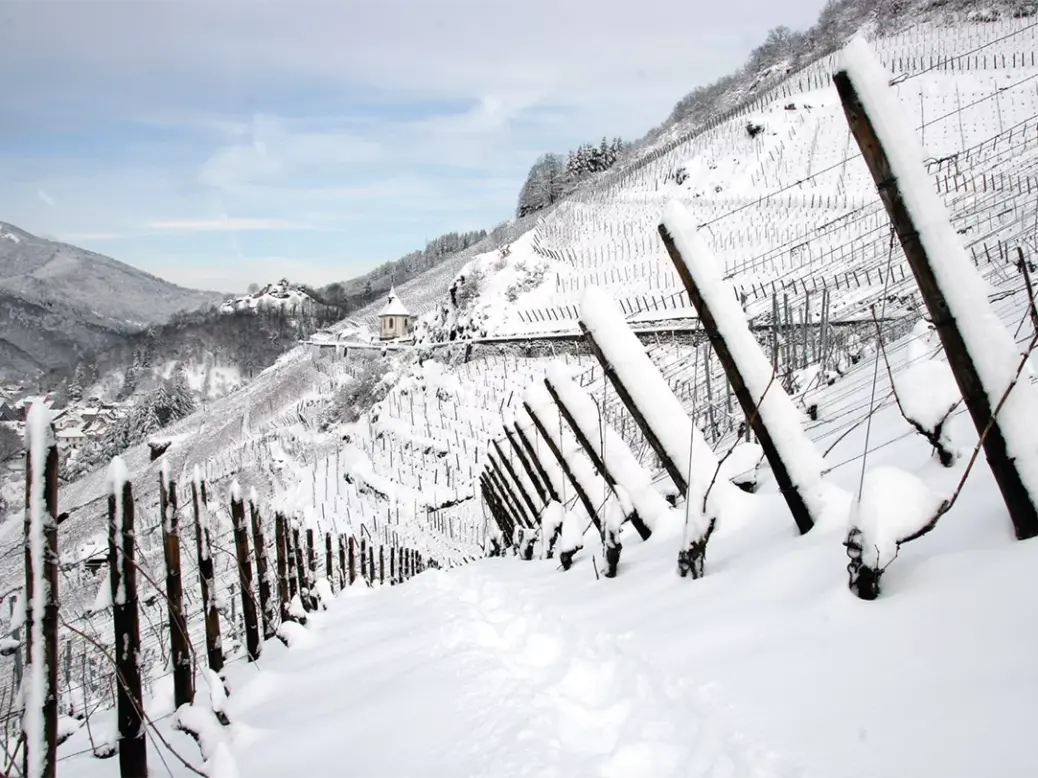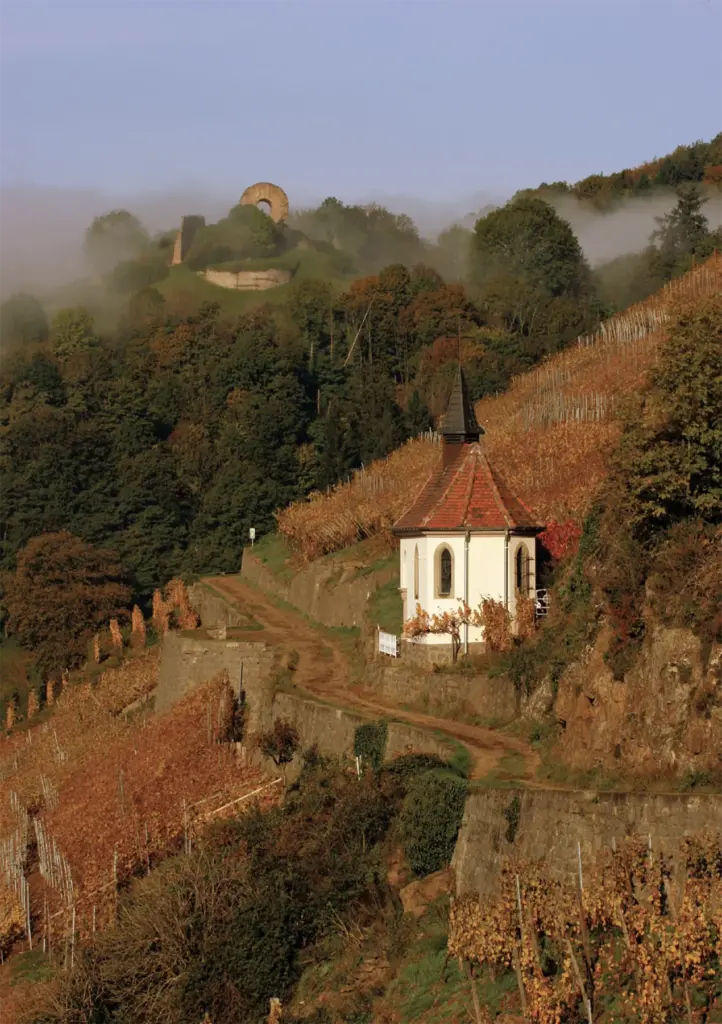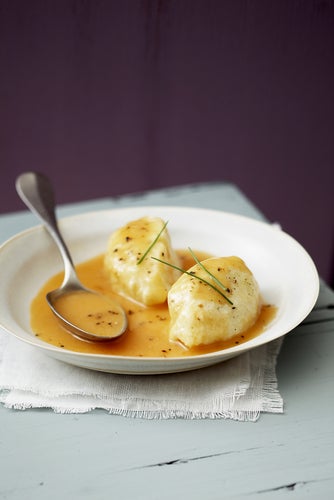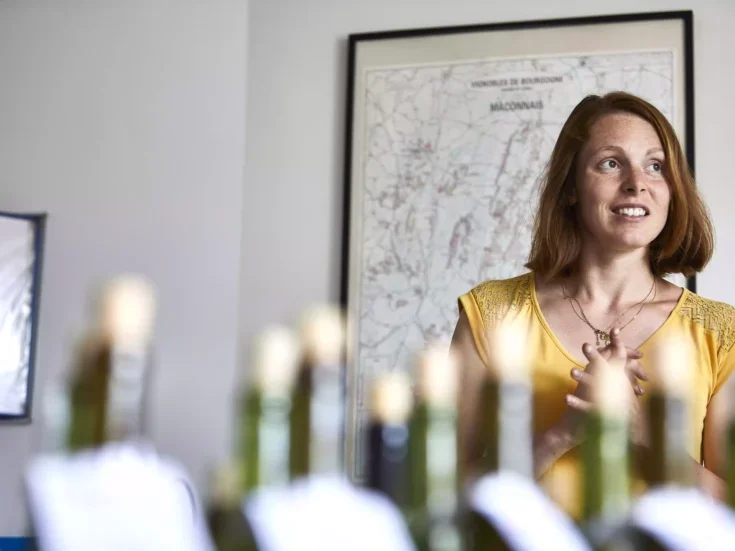
In a classic piece from the WFW archives first published in WFW55 in March, 2017, Margaret Rand explores Rangen de Thann, the highest, steepest, most southerly vineyard in Alsace and the most volcanic of its grands crus, which is as challenging for the talented vignerons who work its slopes as it is rewarding for those fortunate enough to savor its top wines.
It’s always a pleasure to pick up shells in a vineyard. Fossilized clams, scallops, ammonites—you know the sort of thing. Winemakers often display the most massive examples in their tasting rooms. But the soil in Rangen de Thann is volcanic: no chalk, no limestone, no ammonites. The only shells you pick up here are artillery shells. Yikes! Better be careful where you put your feet. Tread on that rusty bit of metal, and you might get more than you bargained for. The winemakers tell tales of people chucking World War I hand grenades down into the river, and boom!
The Maginot Line ran through here. But by then, Thann was already past its winemaking heyday. Records from the abbey of Murbach suggest that Rangen was planted by 1272, and in the 17th century there were 500ha (1,235 acres) of vines in Thann. Most of what is now the town was then vineyards, and some of what is now forest, too. Even so, in the reign of Maria Theresa it was being suggested that more Rangen was drunk in Vienna than the entire village could possibly produce.
By the end of the 1960s, however, just 5ha (12 acres) of Rangen were in cultivation. Phylloxera, world war, and the abandonment of vineyards that were too difficult and too expensive to work had taken their toll. It was only toward the end of the 1970s that one or two growers began to eye Rangen again, and Léonard Humbrecht bought Clos St Urbain in 1977. He was just in time to ensure that Rangen was made a grand cru in 1983. In 1986, Bernard Schoffit bought his first Rangen vines, and he and Zind Humbrecht now have 5.5ha (13.5 acres) each. The rest is divided into ever-smaller parcels: Bruno Hertz has 1.18ha (3 acres), Domaine Maurice Schoech has about 40 ares (1 acre), and Hubert Hartmann at Château d’Orschwihr has just over 20 ares (0.5 acre). Wolfberger has some, the town of Thann has some, and so does the co-op; other growers have small parcels, some for home consumption only. Philippe Zinck is able to buy a third of the harvest from one owner’s 1.8ha (4.4 acres) every second or third year but has never managed to persuade the owner to sign up to a more formal agreement.
It all adds up to 22.13ha (54.7 acres): Rangen is now fully planted. It’s the most meridional vineyard in Alsace, and the highest (you can see the Swiss Alps and the Black Forest on a clear day), and the steepest. And the most dangerous? Olivier Humbrecht MW is reassuring; pretty well everything explosive has been picked up by now, he thinks. Let’s hope he’s right. In any case, he says, the soil is so acidic that metal quickly rusts. The bit you nearly trod on probably wasn’t old enough to be exciting.
Stony and unforgiving
So, where is Rangen de Thann? The answer is that it’s pinned on to the hillside just where the Vosges mountains open out into the plain. The town of Thann, with its pink and yellow houses and its window boxes of petunias and geraniums, spills into the valley, and if you follow the little River Thur past the industrial part of town along the playing fields and the archery ground, there, on the river’s north bank, is Rangen. There is forest above it, forest and some houses to the west, and forest and rocks to the east. The cycle path at the bottom marks the limit of Rangen; the vines on the patch below that, by the archery ground, aren’t even legally Alsace. That cycle path, where people frown at passing cars, marks the boundary between some of the greatest vines in France and some of the least. A vineyard road, built in 1933, carves across the middle of Rangen and zigzags upward in an abstract sort of way; there used to be many more terraces here, says Humbrecht, but most have been smoothed away.
That’s the only thing that is smooth about Rangen. The stones are hard, jagged, dark, and sharp, and on a hot day heat up to what feels like something like their original volcanic temperature. Some 350 million years ago, volcanic activity at the time of the formation of the Hercynian mountain range produced lava and ash, and mountain streams mixed in their sandy sediments. Put all this together, and you get graywacke, tufa, and other volcanic leftovers, with a subsoil rich in iron, magnesium, and sodium. It’s the most volcanic grand cru in Alsace, says Humbrecht; you can find sandstone with volcanic inclusions elsewhere, but Rangen is unique. (The enormous granite boulders that shore up the bottom of the vineyard were shipped in from elsewhere.)
The soil is similar to slate and basalt, and it degrades to clay sheets. (Humbrecht is red hot on this sort of thing, so if I’ve quoted him wrongly, the fault is mine, not his.) Clay, he says, is defined as particles of 2 microns or less. Below this you get particles of different shapes. Clay forms sheets, attached by minerals, and the disposition and thickness of the sheets defines the capacity to absorb minerals; the higher the surface, the better the clay—better for vines, that is. “Rangen can produce very high-surface clay; not much clay but very high quality. It’s a characteristic of many great vineyards in France. Rain gets trapped in its crevices, and so vines need deep roots to access it, and when vines are young, they struggle.
“Very fine silt is not clay. It’s true clay when you can take a handful of earth and roll it into a sausage shape and then into a doughnut [a ring]. True clay will not break, but silt will break when you do the doughnut.”
When you look at Rangen, however, clay is not the thing that comes to mind. It’s stony and unforgiving, and when you stand at the bottom, the rows of vines rise straight up, taut as Riesling; it’s so steep, says Jérôme Keller of Wolfberger, that if you stand on the slope in some parts and stretch out your arm, your hand will touch stones and earth. It’s too steep for tractors, though one optimistic grower did try to mechanize his parcel some years ago—unsuccessfully. Humbrecht points out that if he could get a tractor in, he could plow his 5.5ha (13.5 acres) in half a day. As it is, it takes two men four weeks to plow it.
On the cusp of three climates
The soil is one limiting factor in Rangen—its depth, or lack of it, and the patches, like the bit above the chapel, where nothing will grow. The soil pH is 5.5 at the top and 7 above the river; and because there’s less soil the higher you go, it’s easier to grow vines below the road than above. Vines are so slow-growing that it can be five or six years before an infant vine produces a cane that can be trained. But the other limiting factor is the climate.
It’s high here, and late ripening even though it gets pretty hot. The Thur is at 1,150ft (350m), compared to Colmar at 650ft (200m), and Rangen goes up to 1,530ft (467m). Flowering is one to two weeks later than at Colmar. Growers used to have to wait until November to pick, though the last year that happened was 2008. There’s also about 20 percent more rain than at Colmar, and June, July, and August are the wettest months. (That’s wet compared to Colmar, however, not wet compared to London. Colmar is the driest weather station in France.) This steep, well-drained slope needs water, and usually it has enough, but very dry years don’t suit Rangen. “A Mediterranean climate would be catastrophic here,” says Humbrecht. In fact, it’s on the cusp of three climates: the southern, Atlantic, and continental. Some Mediterranean plants grow here, and they get some continental birds; but added to all that is the river at the foot of the vineyard, which gives fog and humidity. Only the top of Rangen is above the fog line: “At harvest,” says Humbrecht, “from the middle of the vineyard, you can’t see the bottom, and from the bottom, you can’t see the chapel.”

Terroir and varieties
Fog at harvest, as you might guess, equals botrytis. For Riesling, views on botrytis vary with the grower. Jérôme Keller of Wolfberger likes a touch of botrytis on Riesling, while Alexandre Schoffit points out that it can go too fast and give you too much concentration, and the wine can become overpowering and lose tension. “It’s more complicated to get Riesling how you want it than Pinot Gris, because you can get too much botrytis,” he says. “Riesling has only a small window of picking.” Humbrecht likes a tiny bit of botrytis, or none. Riesling can be kept to more or less the same sweetness or dryness level every year, barring freak years. Gewurztraminer is also reliable, but at the other extreme. It has a harder skin than Pinot Gris and takes longer to develop botrytis, but it ripens earlier than Riesling, so it always has the potential for sweet wine, if that’s what you want to make.
With both Riesling and Gewurztraminer you can decide whether or not to make sweet wine. But with Pinot Gris—thin-skinned, fragile, and susceptible to noble rot, as well as other kinds—you seem much more in the hands of the weather gods; it exaggerates vintage differences. Sweetness levels in Pinot Gris go up and down with the year, though not down as far as actual dryness. It can get too heavy, says Olivier: “Few grands crus in Alsace are great for Pinot Gris. But because it’s less aromatic, it shows the vineyard clearly.” In 2013, Schoffit tried to make dry Pinot Gris from Rangen. “We let it go further and further,” says Alexandre, “and it finished fermenting at 8 grams of residual sugar per liter. But it had lost complexity on the way. We declassified all 30hl.”
Those three grapes between them account for the whole of Rangen—and in fact, there’s only just under 1ha (2.47 acres) of Gewurztraminer. Most of the time, Rangen is either Riesling or Pinot Gris. Humbrecht has Pinot Gris planted all around the chapel, the only building in Rangen, which sits in the middle of his Clos St Urbain. (He doesn’t own the chapel: It’s owned by Monsieur Rudloff, a retired baker from Thann, and the current building dates from the 1930s, the earlier one having been damaged during World War I, and the first, 1480, chapel, having been destroyed in the Revolution. It’s still consecrated, and mass is said here once a year, on the last Saturday of June; after mass, naturally, everyone has a glass of Rangen.) “Above the chapel, the wine is more elegant; below it, richer, with more botrytis.”
Schoffit has Riesling in the mid-slope for balance—the top of Rangen is too high for Riesling, says Alexandre—and Gewurztraminer at the bottom. “It’s a lazy grape, and it needs soil for aromatics.” Pinot Gris can be anywhere, but mostly at the top. “It likes a challenge; it likes rocky soil,” says Alexandre. “That’s why it’s possible to have more acidity in Pinot Gris than in Riesling from Rangen.” Schoffit has slightly more Pinot Gris in Rangen than Riesling; for Zind Humbrecht, Riesling is the main Rangen grape. The only Gewurztraminer is grown by Schoffit, Zind Humbrecht, and Schoech, with the last blending it into his Harmonie co-planted wine. But of all the grands crus, says Olivier, “Rangen impacts most on Gewurztraminer. It’s not typical Gewurztraminer; the vineyard character takes over.”
Riesling from Rangen has a distinct, smoky, flinty note that Olivier confirms is from the vineyard, “though I did once tease some sommeliers with different levels of sulfur…” He adds that Rangen Riesling has a very high level of Muscat terpenes—he consulted an aroma specialist on the matter, who discovered three other molecules that he’d never found before in any other Alsace wines, and two of which were unknown to him. Cold years tend to give less floweriness, warm years more Muscat notes, but, adds Olivier, “Rangen is not the most aromatic Riesling in Alsace when it’s young.” And all the Rangen growers agree that Rangen always has a deeper color than anything else they make; that applies to all grapes at the same ripeness levels.
The challenge of Rangen
But if Rangen sounds like the answer to every grower’s dreams, the place where they would kill to buy, think again. Philippe Zinck is able to buy, every two or three years, part of the crop of one Rangen grower, though he has no say in the viticulture and can’t influence the picking date. Tasting his Rangen wines against the wines he grows himself, I remarked that I would like him to own the Rangen vines. Instead of saying, “Yes! Me, too!” he was a bit ho-hum: “It’s a long way to the south”—he’s based in Eguisheim—“and the conditions are different. Here, I wake up, I look at the sky, the clouds, the wind, I can understand what will happen, and I can work accordingly. If you’re not there on the spot, it’s more difficult. In Rangen, it’s hot, dry, and southfacing. Here is like a highway in comparison. If something goes wrong in Rangen, it happens fast. And the investment is enormous. You need financial muscle. If you fail in Rangen, you fail big. If you fall, you fall a very long way. It’s not a place that everyone can handle.”
The challenge of Rangen is perhaps why there’s a chapel dedicated to St Urbain slap in the middle. Who was St Urbain? Naturally, there are several St Urbans. The one we’re talking about here is St Urbain of Langres (327–390), who hid from his enemies in a vineyard. While he was there, he converted the vineyard workers to Christianity, and they in turn helped him as he moved around the countryside. He’s the patron saint of all who work in the wine industry and, in Rangen, has his own special litany, which is added to the Litany of Saints chanted as the procession climbs through the vineyard on its way to mass in the chapel. This, according to Olivier Humbrecht, is how it goes:
St Urbain, compagnon de travail et aide de tous les prêtres du
vignoble du Seigneur,
Priez pour nous!
St Urbain, gardien et protecteur de tous les vignobles et vergers,
Priez pour nous!
St Urbain, patron des vignerons et des aubergistes,
Priez pour nous!
De la boisson et de l’ivrognerie,
Délivrez nous, Seigneur!
Des dévastations de la tempête et du gel,
Délivrez nous, Seigneur!
(St Urbain, work companion and helper to all the priests of the
Lord’s vineyard,
Pray for us!
St Urbain, guardian and protector of all the vineyards
and orchards,
Pray for us!
St Urbain, patron saint of wine growers and innkeepers,
Pray for us!
From drink and drunkenness,
Deliver us, Lord!
From the devastation of tempest and frost,
Deliver us, Lord!)
They forgot to mention world war, artillery bombardments, and demand for cheap wine. You have to spell these things out.






